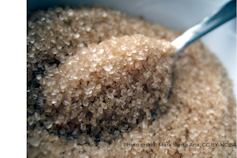
Curious Kids: How much candy do Americans eat in a whole year?

Rahel Mathews, Mississippi State University

Curious Kids is a series for children of all ages. If you have a question you’d like an expert to answer, send it to curiouskidsus@theconversation.com.
How much candy do Americans eat in a whole year? – Yvanna C., age 9, Nevada
From sweet treats to holiday indulgences, candy plays a big role in American culture, with consumption surging around Valentine’s Day, Halloween, Easter and Christmas.
Sugar, whether it’s derived from sugar cane, sugar beets or corn, is a primary ingredient in all candies, partly because it can be masterfully crafted to all sorts of different sizes, shapes and textures. Whether you are nibbling on rock candy, chewing on taffy, munching on jellybeans or licking a lollipop, you’re basically eating spoonfuls of sugar.
The average American consumes an estimated 8 pounds of candy (3.7 kilograms) annually, with children eating even more. On a typical day, 1 in 4 eat at least some candy and almost all of us do it once a year. As a dietitian, I advise moderation, even on special occasions.
That’s because growing kids, and adults too, need food to have enough energy, maintain strong bones and muscles and help their bodies fight infections.
Fruits, vegetables, grains, dairy products and nuts contain natural sugars for energy that are better for you. Those foods also provide nutrients, like iron and vitamin C, that your body needs for good health and survival.
While the sugars in candy do provide plenty of calories for energy, your body doesn’t benefit from those “empty calories.” In fact, your body does not need them at all. Sugars that do not provide health benefits are called added sugars.
What happens when you eat too much candy
Another reason it’s best to eat only small amounts of candy is that if you eat so much of it on an empty stomach that you feel full, your body will get too little of the important stuff it needs.
Eating too much candy, drinking too many sugary beverages and consuming other sources of added sugar can leave you feeling tired and generally unwell in the short term. If you ingest too much sugar all the time, your risk for lifelong health conditions, such as diabetes or heart disease, will rise.
Candy can also harm your teeth, increasing the chances you’ll get cavities. They cause a lot of pain – especially when the roots and nerves of your teeth are damaged.
Making every bite count
Rather than downing an entire bag of gummy worms, eat a couple pieces and save some for later.
It’s also best to fill up on healthier choices. One sweet choice could be a low-sugar yogurt, which has calcium – which is good for your teeth and bones – or an apple, which is packed with vitamin C and fiber.
For a chocolate fix, consider dipping strawberries in melted chocolate – it’s fun, creative and a healthier option.

Just a bit
Like other experts, I recommend that adults and children alike aim for moderation by consuming no more than 10% of their total calories from added sugars.
For young children that can mean limiting added sugars to no more than about 100 calories. That’s about equal to 25 grams at most, the amount in 6 teaspoons of sugar or 24 Skittles.
For teens or adults requiring 2,000 calories daily, sugar should amount to no more than 50 grams – about 200 of those calories.
However, Americans consume sugar in many other ways. Many of us drink sodas and other sugary drinks. We eat other sweet things, such as cake, ice cream, cookies, pie and brownies. Processed foods ranging from bread to spaghetti sauce often include significant amounts of added sugars.
Still, having a little candy once in a while is fine. Just make sure you follow a balanced diet, drink plenty of water and brush your teeth regularly.
Hello, curious kids! Do you have a question you’d like an expert to answer? Ask an adult to send your question to CuriousKidsUS@theconversation.com. Please tell us your name, age and the city where you live.
And since curiosity has no age limit – adults, let us know what you’re wondering, too. We won’t be able to answer every question, but we will do our best.

This article is part of a series examining sugar’s effects on human health and culture. To see all articles on this series, click here.![]()
Rahel Mathews, Assistant Professor of Nutrition, Mississippi State University
This article is republished from The Conversation under a Creative Commons license. Read the original article.

















